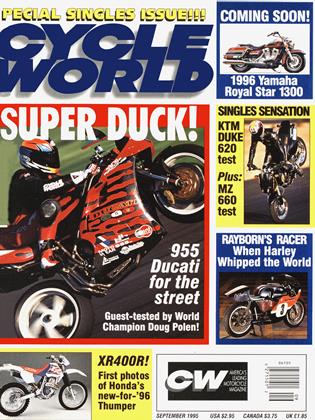STYLE MEETS SINGLE
APRILIA'S VISION FOR THE YEAR 2000?
ALAN CATHCART
IN AN ERA WHEN MOTORCYCLE MANufacturers seem intent upon driving the very bikes they create into leisure-market niches, real-world motorcycles barely exist anymore, at least according to French design guru Philippe Starck.
“In five years, the third millennium will begin,” he says. “Perhaps now is the moment to appreciate that all that surrounds us is image, not reality. Motorcycle design has become strung out on the edge of fashion. Emptied of their meaning and their reason for existence, bikes have become little more than caricatures...With a few rare exceptions, the motorcycle has lost its soul. Now is the moment to reinvent it, to rediscover the essence of what it once was, and will be again. That’s what I’ve tried to do in creating the Moto 6.5-a real motorcycle for the real world.” Strong words that led to a strange bike. Launched at the Bologna Show last December and currently entering production, the Moto 6.5 is the brainchild of Starck and Aprilia boss Ivano Beggio. Beggio and Starck are attempting to lure the public back to two-wheelers by evoking what made motorcycling a mass pursuit in the 1950s and ’60s, when bikes were a basic part of everyday life, to be enjoyed and depended upon in equal measure.
Although you may not care for the Moto 6.5’s radical-chic appearance, its silver-monochrome mask or the odd splash of color on its fuel tank, it is a motorcycle that demands attention. Check out the twin stubs of its exhaust system, made possible by Starck’s stainless-steel, boom-box silencer hidden beneath the engine. How about the narrow, convex radiator that blends into the sump guard? See how the rear light cluster flows out of the curved mudguard.
However, this bike is more than just an esoteric styling statement. Aprilia based the Moto 6.5's dohc, five-valve, liquid-cooled Single on its smoothoperating Pegaso 650 dual-purpose engine. But the 6.5’s Rotax-built, fivevalver was redeveloped using some lessons learned from the BMW F650 four-valve Single Rotax and Aprilia collaborated on, most notably the use of plain main bearings to reduce noise and improve durability. These, in turn, necessitated the use of a new highpressure oil pump. Also, the Pegaso’s twin 33mm carbs give way to a single 40mm Mikuni, and the 6.5’s camshaft design is milder, offering a breadth of power and better low-rpm pick-up.
The controls are incredibly light and easy to operate, from the smoothaction clutch to the gearchange. In fact, this lusty 649cc engine has such a wide spread of power, the five-speed gearbox seems unnecessary-the 6.5 will pull hard from as low as 25 mph in top gear. Aprilia won't quote a power output for the engine, and with no tach, it’s impossible to tell how high it revs. Nonetheless, this bike encourages a relaxed riding style, and it favors the 65-mph mark for cruising.
Given full stick, the 6.5 will grudgingly make its way to 100 mph, but it’s not very happy at high speed. The bars start to flap a little at anything over 75 mph, probably due to a combination of wind catching the rider, and a chassis design with a steep head angle and a rearward weight bias. On the plus side-at least if you like to show off-long, multi-gear wheelies are child’s play (don't ask me how 1 know).
Both wheels were shod with Dunlop Arrowmaxes-the front a 100/90-18 on a 2.15-inch rim, and the rear a 130/9017 on a 3.5-inch rim. These tires were almost ideal for the Aprilia, although I did get a couple of slides from the rear Dunlop under only mildly enthusiastic acceleration. Meanwhile, the Aprilia’s 40mm Marzocchi fork is softly damped, smoothing minor road irregularities without diving too much when you brake hard. The single Brembo front disc is adequate, needing only light pressure to scrub off speed. The single Marzocchi shock gives good low-speed damping, and handles bigger bumps no problem. Unfortunately, a major downside is that it’s only adjustable for preload, and you have to remove the exhaust system to do that-silly. Additional aggravation comes via the fuel tap, which is on the right side of the bike so you must remove your hand from the throttle to switch to Reserve-silly times 2.
Of course, whether the Moto 6.5 is successful depends on the consumer. Aprilia has a total projected production of 150,000 units for 1995, and approximately 3000 are to be 6.5s. Can Aprilia justify making such a large production investment in what may become merely a boutique bike? Beggio is willing to take the chance, because if he’s successful, Aprilia could become a household name-much like Honda in the early '60s. Considering that all 1000 bikes destined for the Italian market have sold out, and that the Moto 6.5 has yet to see style-crazy Japan, prospects look far from grim.
The Aprilia is an ideal bike for city streets and country roads, and for novice riders who may prefer the noise of the world to the noise of their bike. It's quiet, easy to ride, offers light steering and is adequately powerful. The fact that it also looks very different adds to its personality, and stimulates interest. Get used to the look, because even now, Starck is working on his next design for Aprilia. E3
 View Full Issue
View Full Issue
More From This Issue
-
 Up Front
Up FrontSingle-Minded
September 1995 By David Edwards -
 Leanings
LeaningsThe Bikes of Lago Di Como
September 1995 By Peter Egan -
 TDC
TDCIllusion, Disillusion
September 1995 By Kevin Cameron -
 Departments
DepartmentsLetters
September 1995 -
 Roundup
RoundupNew 900ss Ducks On the Way
September 1995 -
 Roundup
RoundupThree's A Charm For Ducati-Ferrari
September 1995






